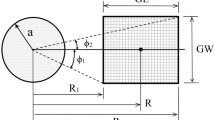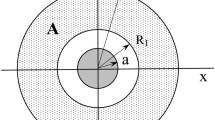Abstract
Residual stress measurement has significant practical implications in the service, security and reliability of components. The hole-drilling method is one of the most popular techniques used to measure residual stress. With hole drilling calibration matrices, it is possible to deduce the variation in stress with depth by incrementally deepening the hole. Calibration matrices for each type rosette of strain gauges contain a large number of discrete redundancy data and the drilling depth must be specified and spaced evenly throughout. Thus, it greatly limits the flexibility of optical measurement methods. For this reason, it is important to have more compact and continuous formulas for the measurement of residual stress. In this paper, the discrete redundancy coefficients have been simplified through formulations. The modified calibration formulas, the error of which is less than 1 %, can improve the performance and flexibility of residual stress distribution measurement across thickness. Meanwhile, it allows us to obtain some special data for any arbitrary depth that are not contained in the hole-drilling strain-gage method.











Similar content being viewed by others
References
ASTM, (2008) Standard test method for determining residual stresses by the hole drilling strain gage method, ASTM International, West Conshohocken, PA., E837-08 ed
ASTM, (2013) Standard Test Method for Determining Residual Stresses by the Hole-Drilling Strain-Gage Method, ASTM International, West Conshohocken, PA., E837-13a ed
Mathar J (1934) Determination of initial stresses by measuring the deformation around drilled holes. Trans ASME 56:249–254
Nelson D (2010) Residual stress determination by hole drilling combined with optical methods. Exp Mech 50:145–158
Rossini N, Dassisti M, Benyounis K, Olabi A (2012) Methods of measuring residual stresses in components. Mater Des 35:572–588
Huang X, Liu Z, Xie H (2013) Recent progress in residual stress measurement techniques. Acta Mech Solida Sin 26:570–583
Schajer GS, Abraham C (2015) Residual stress measurements in finite-thickness materials by hole-drilling. In. Experimental and Applied Mechanics, Volume 6. Springer, pp. 89–97
Mutter M (2015) Correlation of in-situ curvature measurement and hole-drilling method for evaluation of stress states in thermally sprayed coatings. In International Thermal Spray Conference and Exposition (ITSC), (Asm)
Makino A, Nelson D (2016) Hole drilling determination of residual stresses varying along a surface. In Residual Stress, Thermomechanics & Infrared Imaging, Hybrid Techniques and Inverse Problems, Volume 9, (Springer), pp. 347–353.
Winiarski B, Benedetti M, Fontanari V, Al-lahkarami M, Hanan J, Schajer G, Withers P (2016) Comparative analysis of shot-peened residual stresses using micro-hole drilling, micro-slot cutting, x-ray diffraction methods and finite-element modelling. In. Residual Stress, Thermomechanics & Infrared Imaging, Hybrid Techniques and Inverse Problems, Volume 9, (Springer), pp. 215–223
Sasaki K, Kishida M, Itoh T (1997) The accuracy of residual stress measurement by the hole-drilling method. Exp Mech 37:250–257
Schajer G, Tootoonian M (1997) A new rosette design for more reliable hole-drilling residual stress measurements. Exp Mech 37:299–306
Li K (1997) Application of interferometric strain rosette to residual stress measurements. Opt Lasers Eng 27:125–136
Chen J, Peng Y, Zhao S (2009) Comparison between grating rosette and strain gage rosette in hole-drilling combined systems. Opt Lasers Eng 47:935–940
Chen J, Peng Y, Zhao S (2009) Hole-drilling method using grating rosette and moiré interferometry. Acta Mech Sin 25:389–394
Post D, Baracat W (1981) High-sensitivity moiré interferometrya simplified approach. Exp Mech 21:100–104
Ya M, Miao H, Zhang X, Lu J (2006) Determination of residual stress by use of phase shifting moiré interferometry and hole-drilling method. Opt Lasers Eng 44:68–79
Zhang K, Zhao S, Chen J (2015) Improvement of finite element analysis of calibration coefficients for hole-drilling method by general axisymmetric elements. J Chin Soc Mech Eng 36:323–332
Acknowledgments
The authors are grateful for the financial support from the National Natural Science Foundation of China (Grant Nos.11072151, 11372182).
Author information
Authors and Affiliations
Corresponding author
Appendix A Symbols
Appendix A Symbols
- E :
-
Young’s modulus
- μ :
-
Poisson’s ratio
- θ :
-
angle of measuring point from the x-axis
- r :
-
radius of the measuring point
- r o :
-
radius of the drilled hole
- j :
-
number of hole depth steps so far
- k :
-
sequence number for hole depth steps
- H :
-
hole depth so far corresponding to j
- H :
-
stress depth corresponding to k
- ε j :
-
relieved strain measured after j hole depth steps have been drilled
- ε r :
-
radial relieved strain for uniform stress case
- σ r :
-
uniform normal r-stress
- σ θ :
-
uniform normal θ-stress
- σ 1 :
-
maximum principal stress
- σ 2 :
-
minimum principal stress
- D :
-
diameter of the measuring point
- D o :
-
diameter of the drilled hole
- σ x :
-
uniform normal x-stress
- σ y :
-
uniform normal y-stress
- a jk :
-
calibration matrix for isotropic stresses
- b jk :
-
calibration matrix for shear stresses
- A jk :
-
cumulative calibration matrix for isotropic stresses
- B jk :
-
cumulative calibration matrix for shear stresses
- A l j-k :
-
normalized accumulated release formula for isotropic stresses
- B l j-k :
-
normalized accumulated release formula for shear stresses
Rights and permissions
About this article
Cite this article
Zhang, K., Yuan, M. & Chen, J. General Calibration Formulas for Incremental Hole Drilling Optical Measurement. Exp Tech 41, 1–8 (2017). https://doi.org/10.1007/s40799-016-0008-x
Received:
Accepted:
Published:
Issue Date:
DOI: https://doi.org/10.1007/s40799-016-0008-x




